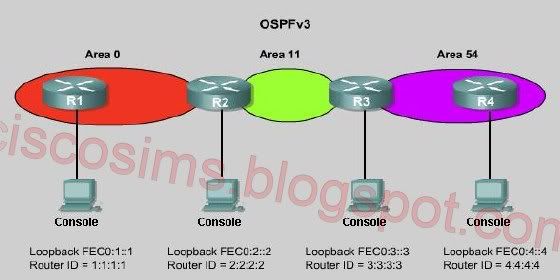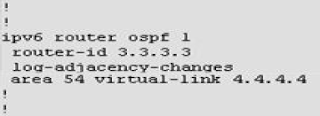Acme is a small export company that has an existing enterprise network that is running IPv6 OSPFv3. Currently OSPF is configured on all routers. However, R4's loopback address (FEC0:4:4) cannot be seen in R1's IPv6 routing table. You are tasked with identifying the cause of this fault and implementing the needed corrective actions that uses OSPF features and does no change the current area assignments. You will know that you have corrected the fault when R4's loopback address (FEC0:4:4) can ping from R1 to R4 loopback address.

Special Note: To gain the maximum number of points you must remove all incorrect or unneeded configuration statements related to this issue.
Solution:
To troubleshoot the problem, first issue the show running-config on all of 4 routers. Pay more attention to the outputs of routers R2 and R3
R2#sh run
R3#sh run
We knew that all areas in an Open Shortest Path First (OSPF) autonomous system must be physically connected to the backbone area (Area 0). In some cases, where this is not possible,we can use a virtual link to connect to the backbone through a non-backbone area. The area through which you configure the virtual link is known as a transit area. In this case, the area 11 will become the transit area. Therefore, routers R2 and R3 must be configured with the area virtual-link
R2>enable
R2#config t
R2(config)#ipv6 router ospf 1
R2(config-rtr)#area 11 virtual-link 3.3.3.3
R2(config-rtr)#exit
R2#copy run start
In the same way configure R3 and remove the wrong command i.e no area 54
R3>enable
R3#config t
R3(config)#ipv6 router ospf 1
R3(config-rtr)#area 11 virtual-link 2.2.2.2
R3(config-rtr)#exit
R3#copy run start
You should check the configuration of all routers, if they have any unneeded configuration then remove it.
After finishing the configuration ping between R1 and R4 to test the configuration.






Unwanted configuration in the sense, how to determine it?
ReplyDelete@ Ashwinkumar
ReplyDeleteYou'll need to issue 'sh run' command and closely look at the configuration. If it contain some other commands which are wrong or not related to the task, you should remove them. For example the above "no area 54...
ok - thank you for the clarification Ciscosims :-)
ReplyDeleteDoes someone seen that "copy run start" command for the lab scenario of OSPF virtual link is not working?
ReplyDeleteneed some help here
ReplyDeletein this question area 11 is configured as ospf using ipv4 addresses on both R2 and R3
how does the connectivity work between area 0 and area 54 which use ipv6\ospfv3 and area 11?
in OSPFv3, there are no IPv4 addresses. In this example RID 4.4.4.4 is strictly just it "router identifier" don't think of it as an IP address because it is not, it is just a way to identify the router.
ReplyDeleteHi Did anyone see this recently in their bsci exam?
ReplyDeleteYes, I saw it today.
ReplyDelete